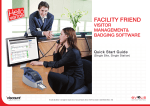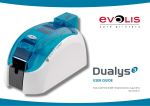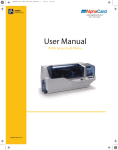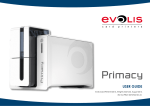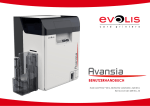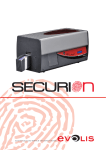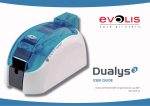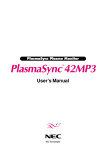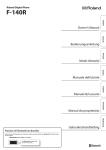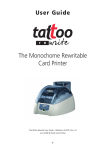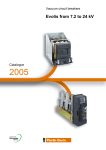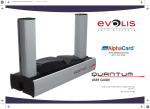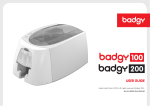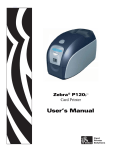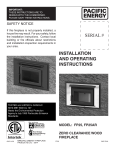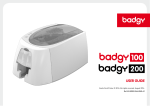Download 4 - ID Wholesaler
Transcript
USER GUIDE Evolis Card Printer© 2014. All rights reserved. April 2014. Ref. KU-AVA1-041-ENG Rev. A0 Copyright Evolis Card Printer© April 2014. All rights reserved. Copyright notice Users must observe the copyright regulations applicable in their country. This manual must not be photocopied, translated, reproduced or transmitted, in whole or in part, for any reason and by any electronic or mechanical means whatsoever without the express written consent of the Evolis Card Printer company. All the information contained in this document is subject to change without prior notice. Evolis Card Printer cannot be held liable for any errors that may be found in this manual, or for any loss or damage arising accidentally or as a result of dissemination or use of this manual. Trademarks is a trademark of Evolis Card Printer. All other trademarks belong to their respective holders. Warranty Refer to the warranty notice supplied with your printer for warranty terms and conditions and limitations. Environmental information – recycling of end-of-life products The manufacture of the equipment that you have purchased required the extraction and use of natural resources. It may contain materials that are hazardous to health and the environment. To prevent the dispersal of such materials into our environment and reduce the pressure on our natural resources, we recommend that you use existing collection systems. These systems will appropriately re-use or recycle most of the materials in your end-of-life equipment. If you need further information on collection, re-use and recycling systems, contact your local or regional waste management body. Do not hesitate to contact us to find out more by visiting our website at www.evolis.com or by emailing the following address: [email protected]. 2 About your new printer Thank you for choosing an Evolis printer. Using your new printer, you will be able to create a wide variety of high-quality cards and badges which can be printed in various colours and styles. This printer uses consumables and accessories available from Evolis. For further details, visit our website at www.evolis.com. Warranty registration Please register on line at www.evolis.com to receive our special offers and general information. Once on the website, click on Drivers and Support and fill in all the fields, giving in particular the model and serial number found on your printer. Getting started The purpose of this user guide is to guide you, step by step, through your printer and how it works. Take some time to read it in order to better understand your printer and its features, and to save time during installation and use. As with all Evolis products, a great deal of care has been taken over this manual. Should you find an error, however, please let us know by emailing us at [email protected]. Contents The bookmarks found top left of your screen can be used to navigate between the various sections in this user guide. Icons The following icons are used in this manual to highlight important information: Information providing further details or depth about certain points in the main text. Indicates that failing to take the recommended action is liable to damage your printer. This symbol indicates that a video showing the procedure is available on the www.evolis.com website. 3 1 Getting started 1-1 Unpacking Your printer is supplied with several accessories that we ask you to look at closely. This list may vary depending on your location. The printer is shipped in special packaging designed to prevent any damage in transit. If you notice any visible damage, do not hesitate to contact the shipper and immediately inform your Evolis reseller, who will tell you the procedure to follow. Evolis takes great care over the quality of its packaging and we ask that you keep this packaging somewhere clean and dry. You will be asked for the full original packaging (outer box, inner wedges and protective bags) in the event that the printer is returned. If the printer is returned without its original packaging and components are damaged in transit, these components will no longer be covered by the warranty. You will be charged for new packaging for shipping the printer back to you. Accessories supplied with your printer: l Mains power cable. l USB cable. l Installation and documentation CD-ROM. l Starter cleaning kit. l Card output hopper. If any of these components is missing, please contact your Evolis reseller. 4 1 1-2 Operating the printer safely The following precautions must be observed to assure safe operation of the printer. Also, do not do anything that is not described in this manual. Doing so may cause an unexpected accident. ä Installing location Do not install the printer: l in a damp or dusty location l on an unstable table, on a slant, or any place where there is excessive vibration. l in a location susceptible to rapid fluctuations in temperature. l in a location exposed to direct sunlight. l near flammable or explosive materials or heater, stove or other device that produces heat Place the printer away from walls to maintain air flow. Also, maintain at least 30cm (12") of open space above the printer and at least 15cm (6") on each side on the printer. Blocking the vents may cause the printer to overheat and catch fire. ä Power supply l Use a dedicated power cable and do not use an extension cord with multiple outlets. l Be sure to remove any dust from the plug and outlet. Humidity produces a micro-current on the surface causing overheating or fire. l Do not damage or modify the Power Cable. Also, do not place heavy objects, pull, or bend excessively. l Do not plug in or unplug the Power Cable if your hands are wet. l Ensure a ground wire is connected. When connecting the ground wire, note the following cautions: l l Recommended connections for ground wires. - Outlet ground terminal - Ground terminals installed as type A, B, or C - A copper rod 65cm (26") or longer buried in the ground. Not permitted for ground wires - Gas piping (risk of fire or explosion.) - Water pipes or taps (water pipes that include plastic piping cannot act as a ground. However, if a water pipe is configured to act as a ground, then connection of a ground wire is permitted.) - Telephone line ground wires or lightning conductors (danger of high current flow in the event of a lightening strike.) l Be sure to turn off the power and unplug the plug from the outlet before moving the printer. l Pull on the plug, not the cable, when unplugging it from an outlet. l Do not use an under-rated extension cord. 5 1 ä Handling Do not use flammable sprays near the printer. Do not touch anything inside the printer unless specified in this manual. Do not place heavy items on the printer and do not lean on the printer. While the printer is operating do not turn off the printer, unplung the power cable, or look inside the printer. The cooling fan is always running for cooling the inside of the printer. This is not a malfunction. The printer may cause static, flickering or interrupt reception or televisions or radios if they are too close to the printer. The lower part of the Top Cover, the printer internal heat roller section, and the thermal head section get very hot. Ensure you do not touch these three locations. ä Security cable You can prevent theft of the printer by locking it with a wire cable. Use a wire cable that fits the Security cable Slot (0.12’’x0.28’’ (3.00mm x 7.00mm)) to lock up the printer. 6 1 1-3 Description of the printer and its functions 1-3a FRONT SIDE OF THE PRINTER 1 - Top cover a 2 - Control Panel 3 - Front cover b 4 - Front cover button 5 - On-off switch c g 6 - Card output hopper 7 - Card ejection slot f e d 1-3b INSIDE OF THE TOP COVER 1 - Card input feeder 2 - Feeding roller 3 - Trapdoor cover 4 - Card case lock a d b c 7 1 1-3c REAR SIDE OF THE PRINTER 1 - Reject slot 2 - Peripheral USB socket 3 - Ethernet socket (Lan cable port ) 4 - Port for enhancing function b c (OPTION) (PC) (10/100) RS-232C(PC) RS-232C(OPTION) a d g e 5 - Security cable slot 6 - Power cable socket 7 - Filter f 1-3d FRONT COVER 1 - Card feeding wheel 2 - Reverse feeding wheel 3 - Cleaning roller Á 4 - Cleaning tape cassette 5 - Reverse wheel 6 - Ink ribbon cassette À Æ Â Ã Ä Ç Å 7 - Transfer film cassette 8 - Key holder 8 1 1-4 Installation 1-4a CONNECTING THE OUTPUT HOPPER 250 max Insert the hooks of the provided Card output hopper to the holes by the Card Ejection Slot. The output hopper is delivered with the printer. Plug it before using the printer. 9 1 1-5 Installation 1-5a CONNECTING THE REJECT BOX 30 max Insert the hooks of the provided Card reject box to the holes. The reject box is delivered with the printer with encoding options. Plug it before using the printer. 10 1 1-5b CONNECTING THE PRINTER ä Connection to the power supply The printer must be connected to a properly protected and earthed electrical installation. FI: Laite on liitettävä suojamaadoitus koskettimilla varustettuun pistorasiaan. NO: Apparatet må tilkoples jordet stikkontakt. SE: Apparaten skall anslutas till jordat uttag. This is a Class B device. This equipment are intended for a use un residential environments but may alose be used in a non residential environments. The residential environment is an environment where the use of broadcast radio and television receivers may be expected within a distance of 10 meters from where this product is used. Ê Plug the power cable connector into the printer. Ë Next, plug the end of the power cable into an earthed power socket. Ì Power up the printer by switching the switch to ON. Í [Initializing...] appears on the LCD, the operating indicator turns blue and [Ready] appears. If the LED indicator turns orange/blinks refer to the troubleshooting section. Before attempting any maintenance, always ensure that the power switch is in the OFF position and that the power cable is unplugged. For your personal safety, ensure that both the switch and cable remain easy to access, especially in the event of an emergency. To save energy, the heater will automatically turns off after 1 hour of inactivity. For more information please see the Reduce printer power consumption 4-5 section of this manual. ä Connecting the USB cable Under no circumstances you must connect the USB data cable before the end of the installation of the printer driver. Refer to the section on printer driver installation for further details, and follow the instructions carefully. 11 1 1-5c RIBBONS AND FILMS Evolis High Trust® ribbons and films optimise your printer’s operation and avoid causing damage to it. The use of ribbons or films from other suppliers is liable to damage your printer and voids the manufacturer’s warranty for the printer. For optimum print quality, Evolis recommends that the printer is fully cleaned every time the ribbons and films are changed. See the Servicing and Maintenance section of this manual. The ink ribbon type is automatically recognized by the printer. There are two types of ribbons in the printer: l Ink ribbons intended for the printing module, identifiable from their purple cores. l Transfer films intended for the Retransfer module, identifiable from their charcoal cores. For optimum print and Retransfer quality, Evolis recommends that the printer is fully cleaned every time the ribbons are changed. This is left to the judgement of users, who will nonetheless take care to comply with the mandatory cleaning cycles in order to keep the equipment in full working condition (see the Maintenance section). 12 1 ä Changing the ink ribbon Before changing the ink ribbon you have to know about the Evolis electronic key which is delivered with every color ribbon. Ê You will have to install the ribbon first and then install the key inside the printer as demonstrated below. Ë The electronic key is equipped with a RFID tag which communicates with an electronic board inside the printer. Without this key, the printer will not print. Ê Ë When installing the electronic key, the Avansia printer instantly identifies the type of ribbon without user intervention. The process is automated from end to end. With this recognition system you will know exactly how much of the ribbon capacity is remaining, as this information is readily available from the Printer Driver on the PC. Similarly, when the ribbon is nearing its end, an alert is displayed on-screen. This helps in estimating the subsequent print jobs possible, and you can ensure not running out of ribbon during the card personalization process. 13 1 ä Fitting the ink ribbon To fit a ink ribbon in the printing module, please proceed as follows: Ê Open the front cover. Ë Remove the ink ribbon cassette. Ì Load new ink ribbon in the cassette. Insert the spool spindle into the feed site (purple) holder. Unwind and load into the shaft as shown. Finally, insert the spool spindle into the winding side holder, inserting the bottom first. Take up the ink ribbon slack. Turn the wheel as shown and take up the ribbon slack. Í Î Insert the ink ribbon cassette until a «click» is heard. Ï Put the Evolis electronic key in the key holder like shown page 13. Ð Close the front cover. Ñ Press the SET Key, when [Push SET Key] appears on the LCD. Ê Í Ì Ë Ï Ñ When placing the ink ribbon down, prevent contamination adhering by placing it with the handle of the bottom. If the ribbon is cut, carefully cut the ribbon with scissors. Use cellophane tape to join the ribbon. Then go back to the step Í. 14 1 ä Changing the Transfer film The transfert unit includes parts heated to high temperatures. Be careful not to put your fingers inside the module. Follow the safety instructions. Ê Open the printer cover. Ë Remove the Transfer film cassette. Ì Push down the pin on the top of the Transfer film cassette. Í Load Transfer film in the cassette. Insert the spool spindle into the feed side (grey) holder.Unwind and load onto the shaft as shown. Finally insert the spool spindle into the winding side holder, inserting the bottom first. Î Attach the pin on top of the Transfer film cassette. Ê Ë Ì Î Í 15 1 Ï Take up the Transfer film slack. Turn the wheel at right and take up the film slack. Ð Insert the Transfer film cassette into the printer until a click is heard. Ñ Close the front cover. Ò Press the SET key when [Push SET Key] appears on the LCD. Ï Ð Ñ Ò When placing the Transfer film down, prevent contamination adhering by placing it with the handle of the bottom. If the film is cut, carefully trim the cut section with scissors. Use cellophane tape to join the film. Then go back to step Î page 15. 16 1 ä Replacement of the Cleaning Roller An adhesive cleaning roller is delivered with the Transfert film, it has to be installed each time you change the film. Ê Open the front cover. Ë Remove the cleaning tape cassette. Ì Lift up the tape spindle. Í Remove the used cleaning tape. Î Insert the new tape and return the tape spindle. Ï Insert the cleaning tape cassette. Ð Close the front cover. Ñ When [Push SET key] appears on the screen, press the SET Key. Ê Ë Î Ð 17 Ì Í Ñ 1 1-5d CARDS For optimum quality, the cards used must be ISO 7810 certified. Use only the card types recommended by Evolis. Do not touch the printable surface of the cards in order to preserve print quality. Keep your cards protected from dust. Do not use cards previously printed with this or any other card printer. Do not use transparent cards, wet cards, cards mixed with glass, metallic or other foreign objects. Do not use cards coated with oil or other foreign matter. Do not use cards that have been damaged, folded, embossed or dropped on the floor The printer accepts PVC, PET-F, PET-G, PC, ABS cards of 0.76mm (30mil). For optimum quality, the cards used must meet the ISO 7810 standard. There are several types: l Blank cards l Magnetic strip cards l Contact smartcards l Contactless smartcards l Magnetic strip smartcards l Pre-printed cards Card (Front Surface) The Retransfer process requires cards to be heated to high temperatures, and they may become slightly warped under the effect of the heat and the stress exerted by the film as it cools. Evolis recommends the use of cards specially designed for Retransfer purposes. For more information, please contact your Evolis reseller who will advise on your choices. Be extremely careful to ensure that magnetic strip cards and contact smartcards are properly positioned in the card feeder. The encoding option will fail if cards are not inserted in the right direction. 18 1 ä Cards orientation The printing side of the card is the surface on the front side of the card feeder (see pictures Ê, Ë, Ì) Pre printed cards (Front surface) Contact smartcards (Front surface) A A A Front side of the card feeder l A l Ê Ë Magnetic strips cards (Front surface + Rear surface) r Rea e ac surf Fro surf nt ace l Front side of the card feeder Front side of the card feeder Ì The magnetic strips of the magnetic cards need to be facing the back side of the card feeder to be encoded (see picture Ì) 19 1 ä Adjusting card thickness The printer accepts card thickness of 0.76mm (30mil). However depending on card thickness tolerance, it may be necessary to ajust it manually. The card thickness gauge is underneath the card feeder. Adjusting card thickness please proceed as follows: Ê Open the printer cover. Ë Remove the card feeder from the printer as shown. Ì Open the cards feeder and remove the cards. Í Return the feeder and adjust the thickness of the cards used by moving the wheel from right to left Î Put the cards back into the feeder and put back the feeder into the printer. Ï Close the top cover of the printer. Card Retainer Ê Ë Ì Align wheel with Marks Î Í 20 1 ä Loading the cards Ê Open the top cover and open the card feeder as shown. Ë Adjust the gauge setting to match the thickness of your cards Ì Hold the card retainer lever with your fingers and pull it right out. Insert the cards in the feeder as indicated, with the side to be printed facing to the left. Î Return the card retainer. Ï Close the top cover. Align wheel with Marks Lock Lever Ê Ë Card Case Roller Rubber Card Retainer Ì Í Load cards in order to start from the right side of the card feeding When printing starts the right-most card is pulled into the printer. You can load card manually, one by one. 21 1 ä Removing printed cards Once the print and/or encoding cycle is complete, cards are delivered by default into the output hopper found on the left of the device. The hopper has a maximum capacity of approximately 250 cards. Users can select from three methods to collect cards from the output hopper: l Front side of card visible – First card at bottom of stack l Rear side of card visible – First card at top of stack To do so, please follows the instructions below: Ê Switch from Normal Mode to User mode (see section 4-1b). Ë Press the t Key until [Card Setup] is displayed, then press the SET Key. Ì Press the t Key until [Card Eject Side] is displayed, then press the SET Key. Í Change the settings by using the t/s Keys, then press the SET Key. NOT SPECIFIED: The rear surface of cards to output cannot be set. Depending on the details of printing, the orientation that will print the most quickly is automatically selected. The front face of the card faces down for single-sided printing, and faces up for doublesided printing. UP: The card is output with its front surface upwards. DOWN: The card is output with its front surface downwards. The factory default setting is [NOT SPECIFY] The method can also be set via the printer driver. 22 1 ä Optimizing transfer conditions In order to optimize the transfer quality you can change the Retransfer settings according to your card type. Thanks to the LCD Panel or the printer driver you can select the card type, then the transfer speed and the transfer temperature. Ê Switch from Normal Mode to User Mode (see section 4-1b). Ë Press the Key until [Card Setup] is displayed. Press the SET Key. Ì Confirm that [Card Type] appears. Press the SET Key. Í Change the settings by using the t/s Keys: PVC (0.76mm) PET(0.76mm) PET-G -0.76mm) If [CARD 1-3] is selected, use the t/s Keys and the SET Key to select the transfer speed and transfer temperature: l left value: transfer speed. The higher the value, the higher the transfer speed is fast. l Right value: transfer temperature. The higher the value, the higher the transfer temperature is hot. The factory default setting is [PVC 30mil/0.76]. The factory default transfer speed for [CARD 1-3] is set to [35mm/s]. 23 1 ä Rejected card management Your printer is equipped with a reject slot, the purpose of which is to separate correctly customised cards from incorrect cards. Incorrect cards are automatically ejected from the slot at the right of the printer. It is possible to switch the Card ejection slot. To do so, please follows the instructions below: Ê Switch from Normal Mode to User mode (see section 4-1b). Ë Press the t Key until [Card Setup] is displayed, then press the SET Key. Ì After using the t/s Keys to switch between [Std card exit]/[Err card exit], press the SET Key. Í Change the settings by using the t/s Keys, then press the SET Key. Card Type SET Std card exit LEFT SIDE Std card exit LEFT SIDE SET Err card exit RIGHT SIDE Err card exit RIGHT SIDE The factory default is set so that correctly printed cards are output from the card ejection slot (Left), and cards with errors are output from the reject slot (Right). 24 2 Printing The information about the procedures described in this section refers to a Windows XP environment. 2-1 Installing the print driver Configuration of the printer and its driver is a very important step and requires very special care. In fact, inappropriate settings are a factor having a negative impact on the quality of card customisation. It is therefore essential to proceed in stages, changing settings only when you are completely sure. Evolis offers the option to revert to the factory settings at any time if the adjustments made do not give the expected results. Your printer is delivered with a DVD containing the print drivers for Windows. To install a print driver, insert the DVD into your computer and select the print driver menu. A program will guide you through the entire installation process. Do not connect your USB cable to your computer until prompted to do so by the installation program. For the connection procedure, see the section on Connecting the Printer. Follow the installation procedure scrupulously. It requires administrator rights to install the driver. 25 2 2-2 Managing the print settings Before using your printer, it is essential to check and/or change the default print driver settings: l Card orientation l Single or dual sided printing l Card finish or treatment l … You will find more detailed information about the cards recommended by Evolis in the Evolis High Trust® list of consumables. Pay attention to the settings defined under the print driver Properties and do not hesitate to contact your Evolis reseller for any advice and assistance needed before making any changes. These print settings are accessible: l From the Start button found bottom-left on the Windows task bar, select Printers and faxes. l Select your printer and double click. l From the Printer menu, select Properties. l The first properties configuration screen for the equipment then appears. l The main tabs used to define the settings are “Card”, “Graphics”, “Configuration” and “Maintenance”. 26 2 ä “Card” tab l Front/back printing l Card orientation, portrait or landscape l Number of copies ä “Graphics” ä “Configuration” l Type of cards l Edge adjustement l Type of ribbons tab l Color settings l Black panel settings l Gamma tab ä “Maintenance” 27 tab l Printing test l Printer details l ID Key information l Printer operation panel 2 2-3 Printing a card A large number of Windows applications allow documents to be printed (for example the tools in Microsoft’s Office suite, i.e. MS-Word, MS-Access, Ms-Excel, MS-PowerPoint). To gain familiarity with the layout of a card and configuring its formatting and printing, we suggest the following example. ä In Microsoft® Word After having set the Evolis printer as the default: l Start the MS-Word application l Click on the File in the menu bar, then on Page Setup l The Paper tab has a Paper Size option, select CR80 Card l In the Margins tab, set all margins to ‘0’, then in the Orientation section, select Landscape. For Word 2010 : click the Page layout tab, then click on Size and select CR80 Card l Close the window by clicking OK. Your Word window should now look like this: You are ready to customise your card by adding the various items that go to make up a card: l Logo and Illustration l Identification photo l Text l Bar code, etc. Once ready, click on File and then on Print. 28 2 2-4 Connecting to a network (Ethernet) All Evolis printers have the benefit of a TCP/IP network connection mechanism. This feature is available as standard or as an option, depending on the model in the range. Out of the box, the printer comes configured in DHCP mode (Dynamic Host Configuration Protocol), which means that its IP address is supplied by the network. In addition to these basic settings, the network administrator has the option of configuring the printer differently in order to comply with the constraints imposed by the corporate LAN: l Printer connected in a subnet, in DHCP l Printer connected within a subnet with fixed IP address, with WINS resolution l Printer connected within a subnet with fixed IP address, without WINS resolution The printer may be identified on the network in two ways: l By its hostname (NETBIOS) l By its IP address. Changing the printer’s basic settings, without prior knowledge of the layout of the LAN in question or without genuine technical knowledge may result in a malfunction of the printer, and may even extend to a more widespread failure of all or part of the LAN. Contact your System and Network Administrator before connecting to or changing the settings for your local area network. 29 2 ä Changing Network connection settings You can configure internet communications settings such as the individual printer ID and TCP/IP-related settings. Ê Switch from Normal Mode to User Mode Ë Press the Key until [Interface Setup] is displayed. Press the SET Key Ì Select the settings to change by using the t/s Keys. Press the SET Key to confirm. Settings Menu Details Printer ID Set the individual printer ID DHCP Set the DHCP function ON/OFF IP Address Set the IP addres (only when the DHCP function is OFF). Subnet Mask Set the subnet mask (only when the DHCP function is OFF). Default Gateway Display the default gateway (only when the DHCP function is OFF). MAC Address Display the MAC address. IPsec Set the IPsec function ON/OFF Timout(s) Set the session timeout (seconds). Password Set the password ON/OFF for settings TCP/IP using the printer driver. If the password is on, set the password. Í Change the settings by using t/s Keys. Press the SET Key. For numerical values, use the t/s Keys to change each digit. Press the SET Key to confirm. Î Turn off and on the printer to enable the settings. The factory default settings are [DHCP], [IPsec] and [Password] set to [OFF]. [Subnet Mask] and [Default Gateway] are set to [0.0.0.0]. [IP Adress] is set to [169.254.0.0]. [Printer ID] is set to [8]. [Timeout(s)] is set to [30]. You can also change the settings by using the printer driver. 30 3 Maintenance 3-1 General warranty information Your Evolis printer has been designed to give you long service and needs only minimal regular maintenance. Please comply with the instructions given below to ensure that it runs satisfactorily. Keep your warranty cover! The manufacturer’s warranty is subject to strict adherence to the routine servicing and maintenance instructions, and in particular the printer cleaning cycles. Any failure to follow the maintenance and servicing procedures described in this section voids the print head warranty. Evolis declines any liability where there has been a failure to carry out required maintenance on the printer. The print head is a wearing part and an extremely sensitive printer component. Its useful life can be seriously curtailed by the presence of dust, liquids or solids in the printer’s immediate environment, on the print head or on the cards. Users must take all necessary precautions to insert only clean cards, free of dust deposits or foreign bodies, into the machine. The frequency and quality of cleaning are decisive factors enabling users to extend the print head’s useful life and to ensure excellent print quality. Particular care must therefore be taken with cleaning. Users must comply with the servicing and maintenance instructions as fully described in this section. Evolis provides replacement parts and consumables that you can refer to within this user guide or by visiting the website at www.evolis.com. In addition, the use of Evolis brand ribbons (Evolis High Trust®) also ensures that your equipment operates properly. Use of ribbons not approved by Evolis may as a consequence affect the quality and reliability of print jobs, produce low quality printed output and even affect the printer’s operation. The manufacturer’s warranty does not cover physical damage or quality problems caused by using nonEvolis approved ribbons. 31 3 3-2 Routine printer cleaning Recommended cleaning cycle: After printing about 1000 cards. Servicing accessory: Adhesive cleaning card. Remove any cards that are inside the printer. Do not touch the roller with your hands. Cleaning cards can only be used once. The frequency and quality of cleaning are determining factors in enabling the user to prolong the life of the print head and printer. Special care will be taken for this operation 32 3 Follow the procedure below: Ê Switch from Normal Mode to User mode (see section 4-1b). Ë Press the t Key until [Cleaning] is displayed, then press the SET Key. Ì Then [Cool down...] is diplayed, wait until the figure drops to 70 or lower. The figure indicates the temperature of the heat roller. Í When [Remove Film] is displayed, open the front cover. Î Remove the Transfer film and close the front cover. Normal Mode MENU Ready Printer Info. SET:>> User Mode Printer Info. SET:>> Cleaning Cool Down SET Cleaning Cleaning Remove Cards SET:>> Ê Ë Ì Î Í 33 Cleaning Cool Down 70 75 3 Ï When [Remove cards] is diplayed, open the top cover. Ð Open the cards feeder and remove the cards from the cassette. Ñ When [Set Cleaning Crd] is displayed, load the cleaning card in the feeding slot. Align the adhesive side of the cleaning card to the right. Ò Ó When [SET:Start] is displayed, press the SET Key. The cleaning starts automatically. Close the cards feeder and the top cover. When [Complete] is diplayed, cleaning is completed and the cleaning card is ejected into the cards ejection slot. Put the film back in the Retransfer module. Your printer is once again ready to use. The adhesive side is on the rear surface Ï Ð Cleaning SET:Start SET Cleaning... Complete Ó 34 Ñ 3 3-3 Servicing the cleaning roller(s) The cleaning roller(s) remove(s) any dust or particles from the cards before printing. Recommended cleaning cycle: when cards are printed with missing colors or if there are foreign objects on them. Follow the procedure below: Ê Turn off the power. Ë Open the front cover Ì Remove the cleaning tape cassette (blue part), hold the cleaning tape cassette handle, lift it and pull. Í Remove the cleaning roller (black part). Î Wipe the rollers clean with a soft cloth fully moistened with water . Ï Load first the cleaning roller (black part) and then the cleaning tape cassette (blue part). Ð Close the front cover. Your printer is once again ready to use. Ë Ì Í Wait for 2 minutes after cleaning before using your printer. 35 Î 3 3-4 Servicing the feeding roller Recommended cleaning cycle: if cards do not feed smoothly into the printer. Ê Turn off the printer. Ë Open the top cover and remove the card feeder. Ì Clean the roller clean with an Evolis’ wipe as shown. Turn the roller as you wipe it to clean it in the direction of the arrow. Í Load the card feeder. Î Close the top cover. Your printer is once again ready to use. Ë Ì Wait for 2 minutes after cleaning before using your printer. 36 3 Recommended cleaning cycle: if the printing location on printed cards is out of adjustment, or there is white space at the edge of printed areas, then clean the secondary transfer section feeding roller at the bottom of the top cover. Ê Turn off the printer. Ë Open the top cover and remove the card feeder. Ì Open the front cover and the top cover. Í Lift the decurl section. Î Wipe the roller clean with an Evolis’ cotton swab fully moistened with water. Ï Return the decurl section to its original position. Close the top cover and front cover. Ë Ì Decurl Section Í Î Be careful the decurl section rollers can be troublesome to clean, don’t hurt your fingers. Besides the heat roller is hot so please exercise care when cleaning. Wait for 2 minutes after cleaning before using your printer. 37 3 3-5 Servicing the reverse roller Recommended cleaning cycle: If card delivery from the reverse section to the secondary transfer feeding roller is not possible, then clean the Reverse Roller. Ê Turn off the printer. Ë Open the top cover and remove card feeder. Ì Open the front cover and the trapdoor cover. Í Rotate the reverse wheel. Î Locate the reverse section roller as shown. Ï Wipe the roller clean with an Evolis’ wipe as shown. Ð Rotate the reverse leading wheel and fully clean the roller. Ñ Close the front cover. Ò Return the card feeder and close the top cover. Your printer is once again ready to use. Reverse Feeding Wheel Reverse Wheel Ë Ì Í Ï Roller Reverse Cloth Wait for 2 minutes after cleaning before using your printer. 38 3 3-6 Servicing the filter cleaning Recommended cleaning cycle: monthly. Ê Turn off the printer. Ë Remove the filter cover on the rear of the printer. Ì Remove the filter from the filter cover. Í Use a vancuum cleaner to clean the filter. Î Hold the filter down with your fingers in order that it is not sucked into the vacuum cleaner. Ï Reset the filter. Ë 39 Í 3 3-7 Primary transfer feeding roller cleaning Recommended cleaning cycle: If a film-related error occurs such as [Film Wind Up], or there is color bleed or image distortion, then clean the primary transfer feeding roller Ê Turn off the power. Ë Open the top cover and remove the card feeder Ì Open the front cover. Í Remove the ink ribbon cassette and the Transfer film. Î Insert a flat screwdriver into the groove on the end of the feeding roller. Ï Turn the screwdriver, and wipe the feeding roller inside the printer using an Evolis cotton swab. Ð Return the ink ribbon cassette and the Transfer film cassette to their original positions. Ñ Close the front cover. Ê Ë Feeding Roller Ì Í Cotton Swab Flat Screwdriver Î Wait for 2 minutes after cleaning before using your printer. 40 Ï 3 3-8 Cleaning the print head As a highly sensitive part of the printer, the print head is a wearable part. Its lifespan can be seriously altered by the presence of dust, liquid or solid elements in the close environment of the printer, or on the print head or cards Directly touching the end of the print head may deteriorate printing quality or cause damage to the printer. The print head is heated to a high temperature immediately after printing. Therefore, do not begin cleaning the print head until it cools down. Ê Turn off the power and remove USB cables and power cables from the printer. Ë Open the front cover and remove the ink ribbon cartridge and Transfer film cartridge. Ì Use an Evolis’ cotton swab to clean the heating element of the print head. Be careful of static electricity when cleaning the print head to avoid issues such as electrostatic damage to the print head. Wait until the alcohol is completely dry before turning the power ON. 41 4 Help This section gives suggestions allowing problems that may arise when using your printer to be pinpointed. If you do not manage to solve your problem, this section also explains how to contact Evolis technical support. 4-1 Introduction to the printer menu The printer has an LCD unit and LED indicator enabling the operator to see the operating condition of the equipment and make adjustments to the most common settings. The control panel comprises 3 units: l One LCD display unit l Four navigation buttons used to move around the menu, and confirm or cancel selections l One dual-colour LED: blue when running normally, orange in the event of a warning requiring the operator’s attention When running, the information shown varies: l Steady blue LED - Ready for printing l Flashing blue LED – Data transfer with the PC or printing in progress l Orange LED - Cards, ink ribbon or transfer film have run out l Flashing orange LED - Cards jammed or other error has occured 42 4 In the event of operator intervention activating the menu, the LCD unit is converted into a dialogue and configuration support interface. The LCD is set in english and Chinese. Generally speaking, unless otherwise indicated, navigation works as follows: 4-1a NORMAL MODE Normal Mode is used for printing cards. When the power is turned on the printer starts in Normal Mode. Normal Mode Message List: Description Initializing The printer is initializing. Remaining cards (abnormal cards) are ejected from the card ejection slot. Ready to print In standby. This awaiting a request to print cards. Now printing Printing cards. 43 4 4-1b USER MODE User Mode is used to set operations and check the status of the printer. To switch from Normal Mode to User Mode, follow the procedure below : Ê Press the Power Switch to turn on the power. When the power starts and the printer turns on in Normal Mode, and [Ready] appears on the LCD Panel. Ë Ì The User Mode top menu is displayed on the LCD Panel. Press the MENU Key. To switch from User Mode to Normal Mode, follow the procedure below: Ê Press the MENU Key severals times to display [Exit Menu]. Ë Press the SET Key. After pressing the t Key several times to display [NO]. You can return to User Mode by pressing the SET Key. After changing settings values using s/t Keys in each menu, press the SET Key to make the changes. Either pressing the MENU Key or turning off the power without pressing the SET Key will mean that changes are not saved in the printer. 44 4 4-2 Warnings and diagnosis Although the Evolis printer was designed to work independently, keeping user involvement to a minimum, it may nonetheless prove useful to gain some familiarity with the main warnings. LCD Display Action required Push SET Key Press the SET Key. Feeder Empty Load cards into the card feeder. Cover Open Correctly close the cover. Low Temperature Ensure the environment temperature is at least 10°C and press SET Key. Check Ribn/Film Confirm that the ink ribbon and Transfer film are correctly loaded. Remove Cards Remove the cards by rolating the Ejection Dial. After clearing an error, pressing the SET key clears the errors, initializes the printer, and [Ready] will appear. 45 4 Warnings and error messages LCD Display Description Action required Cover Open The front cover is open. Yes Close the front cover. Feeder Empty There are no more cards. Yes Load cards into the card feeder. Low Temperature The temperature in which the printer is located is too low. Yes Ensure the environment temperature is 10°C or higher, and press the set Key. No Ribbon The ink ribbon has been used up. Yes Replace the ribbon or Transfer film. Invalid Ribbon The type of ink ribbon cannot be identified by the printer. Yes Reload the ribbon. The ribbon set in the printer and printer settings may be different. Ribbon Wind Up.. The ink ribbon could not be wound correctly. The ink ribbon may be cut. Yes Reload and wind the ribbon up. Repair the cut ribbon. No Film The Transfer film has been used up. Yes Replace the Transfer film. Invalid Film The type of Transfer film cannot be identified by the printer. Yes Reload the Transfer film. Check what kind of Transfer film is supported by the printer. Film Wind Up.. The Transfer film could not be wound up. The Transfer film may be cut. Yes Reload and wind the Transfer film up. Repair the cut Transfer film. No Ribbon/Film Both ink ribbon and Transfer film have been used up. Yes Replace both the ink ribbon and the Transfer film. Cards cannot be fed into the printer. Is the card feeder loaded correctly. The feeding roller is dirty. Yes Press the SET Key. Correctly load the card feeder. Confirm that the card feeder is loaded property. Clean the feeding roller located below the card feeder. There is a card jam. Yes Press the SET Key. An error ocurred, and cards cannot be output. Yes Remove the cards by rotating the ejection dial and press the SET Key. The feeding roller may be dirty. Yes Clean the feeding roller. If the feeding roller is excessively dirty, clean the printer using a cleaning card. Feeder Card Jam Flip Card Jam Printer Card Jam Mag. Card Jam 46 4 Warnings and error messages LCD Display Description Action required There is a card jam. Yes Remove the cards by rotating the ejection dial and press the SET Key. There is a card jam. Yes Remove the cards by rotating the Ejection Dial, and press the SET Key. The feeding roller may be dirty. Yes Clean the feeding roller. If the feeding roller is excessively dirty, clean the printer using a cleaning card. Call TechSupport An error that requires repair may occur. Yes Turn off and on the power. Repairs are necessary if error reoccurs. Firmw. Dwnld err Program version update was interrupted. Yes Turn off and on the power, then start version update again. Reading / writing of the magnetic data failed. Yes Press the SET Key. Mag: Read Error The card set is not in the correct direction. There is scratches or dirt on the card’s magnetic strip. The magnetic characteristics of the card do not match the specifications of the magnetic encoder and the settings of the magnetic encoder. Yes Check the loading direction of the cards. Use undamaged cards. Check the specifications of the magnetic encoder. Chip prt#1:Error During operation of the IC option 1, data reception by the computer was interrupted. Yes Press the SET Key. Chip prt#2:Error During operation of the IC option 2, data reception by the computer was interrupted. Yes Press the SET Key. External Box During operation of the external box, data reception by the computer was interrupted. Yes Press the SET Key. Remove Card:fdr Remove Card:flip Remove Card:prtr Remove Card:mag Mag: Write Error 47 4 4-3 Diagnosis help In this section, you will find all the information you need to carry out a few simple checks that you may be asked to run by your Evolis dealer to help you as effectively as possible. ä Identifying installed software versions You can also identify the version of the print driver installed as follows: Ê From the Start button found bottom-left on the Windows task bar, select Printers and faxes. Ë Select your printer and double click. Ì From the Printer menu, select Printing preferences. Í Go to the Card tab and then click Version. 48 4 4-4 Troubleshooting Do not attempt to use tools or other items to repair your printer in the event of problems, in case major damage is caused. 4-4a PRINTING PROBLEMS ä Nothing prints? Ê Check the print driver Check that there is a print driver for your printer in the Windows configuration. Check that the printer is selected as the default printer. Ë Check the printer’s power supply Check that the power cable is correctly connected to the printer and to a working electrical socket. The printer is on and the display unit says [Ready]. Ì Check the USB cable Check that the USB cable is connecting the printer to your computer. Í Check the ink ribbon and the Transfer film Check that the ink ribbon and the Transfer film are fitted correctly and that the Decurl section’ is locked in place. Î Check the cards Check that there are cards in the card feeder. Check that no cards are jammed in the printer. Ï Print a test card See elsewhere in this section for the procedure to be followed. ä Blank card ejected Ê Check the ink ribbon and the Transfer film Check that the ink ribbon and the Transfer film are not finished or damaged. Replace them or re-install them if necessary. Ë The print head may be damaged Print a test card. If the test card does not print, contact an Evolis reseller for technical support or visit the website at www.evolis.com. 49 4 ä Poor print quality? Small blemishes on the card l l Horizontal white lines l l The card surface may be dirty. Check that your cards are perfectly clean. Use new cards. Avoid using the printer in locations with excessive dust or dirt. Transportation rollers. Use a cleaning card to clean the transportation rollers. See section on how to clean transportation rollers page 34 The ribbon is not correctly fitted. Check that the ink ribbon and the Transfer film are correctly positioned in the printer. Check that there are no wrinkles on the ink ribbon and on the Transfer film surfaces. Print head dirty or damaged. Clean the print head. Blurred image l l l l The ink ribbon or the Transfer film is not correctly fitted. Check that the ink ribbon and the Transfer film are correctly positioned in the printer. Check that there are no wrinkles on the ink ribbon and Transfer film surfaces. Poor ribbon synchronisation. Open and close the front cover to synchronise the ribbon. Dirty printer or cleaning rollers. Use of incompatible cards. Check that the cards used match the specifications. We recommend that you obtain your cards from an Evolis reseller. Use of cards obtained elsewhere is liable to adversely affect print quality and/or damage the print head. If problems persist, please contact your Evolis reseller. 50 4 The card is bent l Secondary transfer conditions are not optimum. l See section correct card curl. l Secondary transfer conditions are not optimum. l Set secondary transfer conditions in accordance with cards used. l Check that the ink ribbon is fitted correctly. Print flakes off White cards 51 4 ä Partial or incorrect printing Ê Check the print settings Check that no area of the card design to be printed is outside the print margins. Check the document orientation (portrait or landscape) in the print driver configuration. Ë Check the interface cable If irregular characters are printed, check that you are in fact using the USB cable supplied with your printer. Check the connection between the computer and the printer. Try using another cable of the same type. Ì Check that the printer is clean Clean the printer, especially the cleaning rollers. See the maintenance section. Í Check that the cards are clean Store your cards protected from dust. Î Check the ink ribbon and the Transfer film Check that the ink ribbon and the Transfer film are fitted correctly. Check that the ink ribbon and the Transfer film spool freely. Ï Check the print head Should horizontal straight lines appear on printed cards, it is likely that the print head is dirty or damaged. See the section on maintenance and troubleshooting. If the problem persists, contact an Evolis dealer or visit the website at www.evolis.com. 52 4 ä Correcting card curl Ê Switch from Normal Mode to User Mode (see section 4-1b) Ë Press the t key until [Card Setup] is diplayed. Then press the SET Key. Ì Press the t key until [Decurl Time(s)] is diplayed. Then press the SET Key. Í Change the settings by using the / Keys. You can set the decurl duration from 0-5 seconds. There is no decurl if the settings value is set to «0». Î Press the SET Key to fix the changes. Normal Mode MENU Ready Printer Info. SET:>> User Mode Printer Info. SET:>> SET Card Setup SET:>> Ê Card Type Ë Decurl Time(s) 5 Card Type SET Decurl Time(s) 0 Decurl Time(s) 0 Decurl Time(s) 0 Ì Í The factory default setting is «0». You can also change the settings by using the printer driver. Secondary transfer conditions that have not been optimized and application of excess heat are major causes of cards curling after printing. Please adjust the secondary transfer conditions. 53 4 4-4b FREEING JAMMED CARDS Do not turn your printer off, as this cancels pending print jobs in the printer’s memory. Never use any kind of tool (screwdriver, sharp object, etc.) to free the card. You risk causing serious damage to the rollers, especially the unit’s hot roller. Any such damage will not be eligible for cover under the warranty! To prevent card jams: Ê Check that the card thickness gauge is correctly adjusted. Ë Check that the thickness of the cards used matches the specifications set out in Appendix A “Technical specifications” in this manual. Ì Check that the cards are flat. Í Check that the cards are not stuck together. Shuffle the cards before loading them. 54 4 ä Freeing a card in card feeder When a card becomes jammed in the card feeder, the message ‘Card Jam Feeder’ appears on the control panel display. Print jobs are interrupted. Do not turn the device off, as this will result in the loss of current print jobs stored in the printer’s memory. Ê Open the top printer cover and the front cover. Ë Remove the card feeder. Ì If the most right card is partially fed into the printer, slowly pull it out by hand. Í Insert cards into the card feeder. Î Close the card feeder and the printer cover. Ï Press the SET Key. The error message on the LCD panel disappears and the printer restarts. ä Freeing a card in the Retransfer unit When a card becomes jammed in the card feeder, the message ‘Card Jam Feeder’ appears on the control panel display. Print jobs are interrupted. Do not turn the device off, as this will result in the loss of current print jobs stored in the printer’s memory. Ê Open the top printer cover. Ë Remove the card feeder. Ì Rotate the reverse feeding wheel. Remove cards jammed in the cleaning section from the feed slot. Í Return the card feeder and insert cards. Î Close the card feeder and the printer cover. Ï Press the SET Key. The error message on the LCD panel disappears and the printer restarts. Reverse Feeding wheel Feed slot 55 4 Freeing a card in the reverse section Ê Open the top printer cover and the front cover. Ë Remove the card feeder. Ì Release the lock on the decurl section as shown before lifting. Í Remove the cleaning roller and cleaning tape cassette. Î Rotate the reverse wheel and rotate the feeding wheel left or right. Cards will be ejected by the right or left ejection slot (depending on the rotation of the button). Ï Insert cards into the card feeder. Ð Before closing the top cover and front cover, return the card feeder, decurl section, cleaning roller and cleaning tape cassette their original positions. Ñ Press the SET Key. The error message on the LCD panel disappears and the printer restarts. Reverse Feeding wheel Feeding wheel Reverse wheel Once the card is free, make sure that the film is correctly positioned and then close the printer cover. The printer restarts. If the Retransfer unit is too hot, turn the printer off and wait for the module to cool down (this can take several minutes). Try once more to free the card manually. If, despite your best efforts, the card remains jammed, contact your Evolis reseller for on-site assistance from an engineer. 56 4 4-4c REPLACING THE PRINT HEAD The print head is a sensitive component of your equipment. It determines the print quality, and regular servicing along with an immediate environment free from dust or other particles ensure a lengthy useful life. Nonetheless, the print head may sometimes need to be replaced. Before doing anything else, please contact your Evolis reseller in order to check the advisability of replacing the print head. The reseller will supply a new print head if need be. Evolis has set up a scheme for exchanging defective print heads during the printer’s warranty period. Your equipment is eligible under the scheme if: You use only Evolis consumables (ribbons and maintenance products). l You have followed the cleaning and servicing cycles scrupulously. l You are working in a dust-free environment complying with the technical specifications. l 57 4 4-4d UPDATING THE FIRMWARE (UNDER WINDOWS) Updating the firmware is a simple operation but one which, if not properly completed, can result in your printer breaking down. Before any update, please contact your Evolis reseller who will be able to guide you on the advisability or otherwise of carrying out an upgrade. In general, such updates are only required in the event of problem or malfunction that has been clearly identified by your Evolis reseller. Updates can be downloaded from the website at www.evolis.com: Ê Go to drivers & support section Ë Select your printer model. Ì Then click on the file for the corresponding Firmware. Í Accept the download then save the file in a directory on your hard drive. The firmware may be stored compressed as Î Ï Ð Ñ a zip file, which you will need to extract. Then go to Control Panel, Devices and Printers, Printer Properties, Utility and click on Printer firmware update. Now look in the directory for the firmware installation program, and open it. When prompted by the program, click on the Download button to run the job. The firmware download is in progress. After about thirty seconds, the firmware has transferred to the printer and the operation is complete. If the printer is not showing a ‘READY’ status, this means that the update has not been carried out correctly or, possibly, that the printer is not working properly. Check the connection cables and run a new update. The update is complete, and your equipment is ready to customise your cards. Never interrupt the transfer between computer and printer during the download phase (powering off the printer or computer, unplugging a cable). This would result in a complete inability to restart the printer. Should such an incident occur, please contact your Evolis reseller. 58 4 4-5 Reduce printer power consumption Select the power saving mode for when the printer is not being used. Ê Switch from Normal Mode to User mode (see section 4-1b) Ë Press the t Key until [Printer Setup] is displayed, then press the SET Key. Ì Press the t Key until [Power Save Mode] is displayed, then press the SET Key. Í Change the settings by using the t/s Keys, then press the SET Key. Normal Mode MENU Ready Printer Info. SET:>> User Mode Printer Info. SET:>> SET Printer Setup SET:>> Ê Buzzer Ë Power Save Mode HEATER OFF Buzzer SET Power Save Mode MAIN POWER OFF Power Save Mode MAIN POWER OFF Power Save Mode MAIN POWER OFF Ì Í The factory default setting is [HEATER OFF]. You can also reduce the printer power consumption on the printer driver. 59 Power Save Mode KEEP READY 4 4-6 Counting the Number of cards that are printed You can also count the number of cards that have been printed in a specidifed period of time by resetting the count with the SET Key. Ê Switch from Normal Mode to User mode (see section 4-1b) Ë Confirm that [Printer Info] appears, and press the SET Key. Ì Confirm the [Card Count] display. Pressing the SET Key will return the display to [0]. You can also display the total number of sides that are printed. This can be used as a guideline for doing maintenance. Press the t Key until [Total Count] is displayed. This count cannot be reset. Í Normal Mode MENU Ready User Mode SET Printer Info. SET:>> Printer Info. SET:>> Ê Card Count Ë Card Count SET Card Count Total Count Reset ? 3 30 Ì Í The Total count displays shows several cards have been printed when the printer is shipped from the factory because the count increases during the production process. You can also display the total count and the count of cards printed on the printer driver. 60 4 4-7Checking the types of Ink ribbon and Transfer film that are loaded Ê Switch from Normal Mode to User mode (see section 4-1b). Ë Confirm that [Printer Info] appears, and press the SET Key. Ì Press the t Key until [Ribbon Type] or [Film Type] is displayed. Printer Info. SET:>> Normal Mode MENU Ready User Mode Ribbon Type 5P(CMYKP) Printer Info. SET:>> Ê SET Printer Info. SET:>> Card Count Film Type CLEAR Ë You can also check the types of ink ribbon that is loaded on the printer driver: Ê From the Start button found bottom-left on the Windows task bar, select Printers and faxes. Ë Select your printer and double click. Ì From the Printer menu, select Printing preferences. Í Go to the Maintenance tab and then click Ribbon Details. 61 Ì 4 4-8Checking the program version and serial number Ê Switch from Normal Mode to User mode (see section 4-1b) Ë Press the t Key until [Version] is displayed, then press the SET Key. Ì Press the t/s Keys to display the information to check. Normal Mode MENU Ready User Mode Printer Info. SET:>> Ê Printer Info. SET:>> SET Version Info. SET:>> Base Version Ë Ì The t/s Keys allows you to switch between [Base Version], [Main Version], [Printer S/N], [Printhead S/N], [Magnetic Encoder],[Chip port #1], [Chip port #2], [External Box]. You can also check the program version and serial number on the printer driver: Ê From the Start button found bottom-left on the Windows task bar, select Printers and faxes. Ë Select your printer and double click. Ì From the Printer menu, select Printing preferences. Í Go to the Maintenance tab and then click Printer operation panel. Î Double click on User Mode and then click on Version. 62 4 4-9Turning the Error alarm ON or OFF The initial setting is for the buzzer to sound when an error occurs. You can set the buzzer so that is does not sound. Ê Switch from Normal Mode to User mode (see section 4-1b) Ë Press the t Key until [Printer Setup] is displayed, then press the SET Key. Ì Confirm that [Buzzer] appears, and press the SET Key Í Change the settings by using the t/s Keys, then press the SET Key. Normal Mode User Mode MENU Ready Printer Info. SET:>> Printer Info. SET:>> SET Printer Setup SET:>> Ê Buzzer Ë Buzzer ON Buzzer ON SET Buzzer ON Buzzer OFF Ì Í You can also turn the error alarm ON or OFF on the printer driver. 63 4 4-10 Others functionalities Some extra functionalities are by factory default disabled, here we will see how to enabled them. ä Parallel print By default the Parallel Print is OFF, the printer does not print another card until the previous card finishes printing (prints one card at a time). This functionality allows the printer to performs parallel processing (continuous printing). It prints up to two cards at once through parallel processing within the printer. This functionality increase the printing speed, however it does not manage the errors. For example, when an error of encoding occurs, the printer carries on and does not re-encode the card (the card is ejected by the reject slot). Ê Switch from Normal mode to Service mode. To do so, keep pressing the MENU key and in the same time press the s key, t key, and again s key, t key. [Service Mode] appears. You can stop pressing the MENU Key. Ë Ì Press the t Key until [Parallel Print] is displayed. Then press the SET Key. Í Change the settings by using the t/s Keys, [ON] or [OFF], then press the SET Key. Press the t Key until [Printer Setup] is displayed. Then press the SET Key. ä Card Empty Check By default the Card Empty Check is OFF, the LCD printer displays an error when the printer detects the absence of cards while accepting a print request (Starts printing after canceling the error). This functionalities allows the printer to display an error and wait until it detects cards again. Ê Switch from Normal mode to Service mode. To do so, keep pressing the MENU key and in the same time press the s key, t key, and again s key, t key. [Service Mode] appears. You can stop pressing the MENU Key. Ë Ì Press the t Key until [Card Empty Check] is displayed. Then press the SET Key. Í Change the settings by using the t/s Keys, [ON] or [OFF], then press the SET Key. Press the t Key until [Printer Setup] is displayed. Then press the SET Key. 64 4 ä Short Size Print This functionality turns partial printing of color data on and off. By default the printer always prints (temporary transfer) on the entire surface of card. If you turn the Short Size Print ON the printer will perform partial printing (primary transfer) on the effective area (zone with data other than 0 tone) only within color data. It may reduce the time required to print the cards depending of the design or layout of the color data. Ê Switch from Normal mode to Service mode. To do so, keep pressing the MENU key and in the same time press the s key, t key, and again s key, t key. [Service Mode] appears. You can stop pressing the MENU Key. Ë Press the t Key until [Printer Setup] is displayed. Then press the SET Key. Ì Press the t Key until [Short Size Print] is displayed. Then press the SET Key. Í Change the settings by using the t/s Keys, [ON] or [OFF], then press the SET Key. ä Language Set the Language to be used for displaying error messages and for the user mode menu on the LCD screen. By default the LCD displays messages in English but the simplified Chinese is also available. Ê Switch from Normal mode to Service mode. To do so, keep pressing the MENU key and in the same time press the s key, t key, and again s key, t key. [Service Mode] appears. You can stop pressing the MENU Key. Ë Press the t Key until [Printer Setup] is displayed. Then press the SET Key. Ì Press the t Key until [Language] is displayed. Then press the SET Key. Í Change the settings by using the t/s Keys, [ENGLISH] or [CHINESE], then press the SET Key. 65 4 4-11 Technical support If you are having difficulties in configuring and using your printer, read this manual carefully. If you do not manage to solve your problem, you can obtain further information and help from the Evolis partner network. 4-11a EVOLIS PARTNER NETWORK For any unresolved technical problem, contact an Evolis reseller. If you do not know any Evolis resellers, visit the www.evolis.com website and send us your question. Evolis will pass on the contact details of your nearest Evolis reseller. When calling an Evolis reseller, you do need to be close to your computer and ready to provide the following information: Ê Your printer model and serial number. Ë The configuration and operating system that you are using. Ì A description of the incident that has occurred. Í A description of the steps that you have taken to resolve the problem. In addition, to enable you to find answers to your questions 24/7, the www.evolis.com website includes a number of aspects related to day-to-day use of your printer. 4-11b FINDING INFORMATION ON WWW.EVOLIS.COM If you need additional technical help, you will find a great deal of information on using and troubleshooting Evolis printers under the Drivers and Support section on the Evolis website at www.evolis.com. This section offers downloads of the latest versions of firmware, print drivers and user manuals, videos about using and maintaining Evolis printers, and an FAQ* section giving answers to the most frequently asked questions. FAQ : Frequently Asked Questions * 66 A Appendix A A1 - Technical specifications This section presents your printer’s technical printing properties. ä General features l Dual-sided printing (standart) l Reverse transfer printing l Over the edge printing l Color dye sublimation and resin monochrome retransfer l 600 dpi print head (23.6 dots/mm) l Bitmap: 24 bits, R/G/B 256 level l Printout: Y/M/C 256 level l 64 MB of memory (RAM) ä Printing l performances Full cards: l Single side (YMCK): 25 s/card - 144 cards/hour l Dual side (YMCKK): 37.5 s/card - 96 cards/hour ä Additional l encoding modules Available modules: l Magnetic stripe encoder ISO 7811 l Dual contact and contactless encoder l Encoder connectivity: internal USB hub, 1 port available l Encoding options can be combined l Factory ordered ä Interfaces l USB 2.0 l Ethernet TCP-IP 10BaseT, 100BaseT (Traffic Led) 67 A ä Safety RFID locking key l Support for security lock (Kensington® type) l Centralized locking system to secure access to blank cards, ribbon and film (optional)2 l 2 Option subject to approval from Evolis ä Card management and specifications l Card feeder: 250 cards (0.76 mm - 30 mil) l Card output hopper: 250 cards (0.76 mm - 30 mil) l Reject tray capacity: 30 cards (0.76 mm - 30 mil)3 l Card thickness: 0.76 mm (30 mil), manual adjustment l Card types: PVC cards l l Composite PVC cards l PET-F cards l PET-G cards l Polycarbonate cards l 3 ABS cards Card format: ISO CR80 - ISO 7810 (53.98 x 85.60 mm - 3.370’’ x 2.125’’) Delivered with any printer including encoding option(s) ä Evolis High Trust® ribbons To maximize the quality and durability of printed cards, the lifespan of the print head and the overall printer reliability, use Evolis High Trust® ribbons. l Ribbon capacity: l Clear Transfer film: 500 prints/roll l Holographic Transfer film: 400 prints/roll l YMCK: 500 prints/roll l YMCKK: 400 prints/roll l YMCKI (for cards with chip and/or magnetic strip): 400 prints/roll l YMCKH (for Polycarbonate cards): 400 prints/roll l YMCFK (UV ink): 400 prints/roll 68 A ä Software l Compatible with WindowsTM XP SP2 32, Vista 32, W7 32/64 and W8 32/64 ä Display l Two-line LCD display and LED status indicator l Printer graphical notifications: empty input hopper, empty/low level ribbon alert... ä Certifications l RoHS l CE, FCC, UL, IEC ä Power l and statement of compliance supply AC90-125V, 220-240V, 50/60Hz ä Operating environment l Min/max operating temperature: 10° / 30° C (50°/86°F) l Humidity: 20% to 80% non-condensing l Min/max storage temperature: -20° / 60° C (-4° / 140°F) l Storage humidity: 20% to 90% non-condensing l Operating ventilation: open air ä Sound (evaluated according to the ISO 7779 standard) Sound pressure in assistant positions LpAm (color mode YMCK) l When operating: 53 dB (A) l While waiting: 45 dB (A) ä Packaging content l Printer l CD-ROM with printer drivers, user manuals and Quick Start l Cleaning materials l USB cable l Output hopper l Power cord 69 A ä Size and weight l Dimensions (HxWxD): 436x340x297 mm (17.16’’x13.38’’x11.69’’) l Weight: 20 kg (44.09 lbs) ä Warranty4 l 4 3 years for printer, lifetime warranty on print head Warranty subject to observance of specific conditions and use of Evolis High Trust® ribbons 70 B Appendix B B1 - Encoding options Some models of Evolis printers are equipped with encoding systems which are used to customise magnetic strips, and contact and contactless smartcards. Depending on the model, it is possible to install up to three types of encoder in the printer (magnetic strip, contact and contactless smartcards). B1a - MAGNETIC STRIP ENCODING A printer fitted with a magnetic encoder works in exactly the same way as a basic card printer. The Evolis encoder encodes the magnetic strips in a single pass then runs a data check. Configurable as high coercivity (HiCo) or low coercivity (LoCo) by a simple click in the Windows print driver, Evolis magnetic encoders are however shipped with a default setting of high coercivity (HiCo), unless otherwise requested when placing the order. ä Location of the magnetic encoder The magnetic encoder is a module fitted in the factory. The read-write head is located in a module under the flip-over station. The encoding sequence for a card is always carried out before the printing. Use only magnetic strip cards that comply with ISO 7810 and ISO 7811 standards. The magnetic strip must be moulded into the card to work properly. Never use cards with a glued-on magnetic strip. 71 B ä Card positioning You can set the orientation of loading magnetic cards. You can also change the settings by using the printer driver. This setting is only available when the optional encoder unit is attached. Ê Switch from Normal mode to User mode. Ë Press the t Key until [Card Setup] is displayed. Then press the SET Key. Ì Press the t Key until [Set card side] is displayed. Then press the SET Key. Í Change the settings [Standard] or [Reverse] by using t/s Keys, then press the SET key. [Standard] : [Reverse] : Ê Open the Top cover. Ë Open the card feeder. Ì Insert magnetic cards depending on the mode. Close the card feeder and the top cover. Í The factory default setting is [Standard]. Printing on the magnetic strip terminal cannot be guaranteed. 72 B ä Configuring the Windows print driver Coercivity sets the magnetic encoding to high (HiCo) or low (LoCo) coercivity. A magnetic strip that is encoded in high coercivity is more resistant to external disturbance than a magnetic strip encoded using low coercivity. How to configure the coercivity: Switch from Normal Mode to Options mode. To do so, maintain the MENU Key pushed 5 seconds. Press the t Key until [Options Mode] is displayed. Then press the SET Key. Ê Ë [Magnetic encoder] is displayed, press the SET Key. Ì Press the t or s Key until [Coercivity] is displayed. Then press the SET Key. Change the settings by using the s/t Keys, [HIGH] or [LOW], then press the SET Key. Í ä ISO Track number 7811 magnetic encoding standards Separator Density Character set Number of characters Track 1 ^ 210 ppp1 Alphanumeric (ASCII 20-95)2 793 Track 2 = 75 ppp1 Numeric (ASCII 48-62)2 403 Track 3 = 210 ppp1 Numeric (ASCII 78-62)2 1073 bits per inch Except for the “?” character 3 Including the Start, Stop and LRC characters which are automatically handled by the magnetic encoder 1 2 73 B B1b - CONTACT SMARTCARD ENCODING A printer fitted with a smartcard contact station works in exactly the same way as a basic card printer. The Evolis smartcard contact station is used to program chips to ISO 7816-2 standards. ä Contact station location The contact station is a module fitted in the factory. It is located under the flip-over station. To make contact with the station, the smartcard is pushed into the station. The programming sequence for a smartcard is always carried out before the printing. Use only smartcards compliant with the ISO 7816-2 standard. Never print over the chip. ä Card positioning Before loading IC cards, you need to set the orientation of cards. The factory default setting is [Standard]. Ê Switch from Normal mode to User mode. Ë Press the t Key until [Card Setup] is displayed. Then press the SET Key. Ì Press the t Key until [Set card side] is displayed. Then press the SET Key. Í Change the settings [Standard] or [Reverse] by using t/s Keys, the press the SEt key. [Standard] : 74 The IC terminal is on the rear surface of the card Fron surf t ace B [Reverse] : Ê Open the Top cover. Ë Open the card feeder. Ì Insert IC cards depending on the mode. The IC cards should be always positioned with the IC terminal near the cover top. Close the card feeder and the top cover. Í Printing on the IC terminal cannot be guaranteed. 75 B DB-9 connector pins Smartcard contact points 1 C1 : Vcc 2 C2 : RST, Reset 3 C3 : CLK, Clock 4 C4 : Reserved 5 C5 : GND, Ground 6 C6 : Vpp 7 C7 : I/O, Input/Output 8 C8 : Reserved 9 C9 : OPTO+, Card detection signal A sequence of commands must be sent via the printer’s interface to insert a card into the printer then position it under the station and establish contact (see programming manual). The command sequence is as follows: l A card is moved from the feeder to the contact station, and stops in it. l The card is pushed upwards to make contact with the station. l The printer connects the contact station to the DB-9 connector. l The chip is programmed via the external coupler. Refer to the Evolis printer SDK for further details on programming smartcards. The Evolis product catalogue has printers equipped with a chip contact station and a built-in encoder. Depending on the model, these encoders connect to the PC via a USB interface. 76 B B1c - CONTACTLESS SMARTCARD ENCODING Evolis printers may be equipped with an encoding device for contactless smartcards (RFID). This consists of an encoding module and sometimes a detachable antenna. Integration of such a module must be carried out by specialist. The Evolis product catalogue has printers equipped with a built-in encoder for contactless chips. There is a very wide variety of contactless cards, and each card has specific technical properties associated with an equally specific type of encoder. See your Evolis reseller for further information. ä Location of the antenna (or the encoder including an antenna) By means of a specific command, the card is positioned close to the antenna such that the card lies within its radio range. Reading data from or writing data to the card can then start. The programming sequence for a smartcard is always carried out before the printing. ä Card positioning On the face of it, there are no restrictions on card positioning when programming in contactless mode. However, the miniaturisation of components is bringing about the emergence of cards fitted with mini-antennae. In this situation, please see your card supplier for further information about where such mini-antennae are located within the card, so as to present the card as close as possible to the encoder’s antenna. Doing so will ensure optimum encoding of the cards. 77 B ä Computer connection The encoder is integrated inside the printer, to connect it to your computer you just have to plug the USB cable from your printer to your computer. A sequence of commands must be sent via the printer’s interface to insert a card in the printer then position it close to the antenna to establish radio communication between the card and the encoder (see programming manual) The command sequence is as follows: l A card is moved from the feeder towards the antenna and is positioned nearby. l The chip is programmed via the built-in encoder and the computer. Refer to the Evolis printer SDK for further details on programming contactless smartcards. 78 C Appendix C C1 - Certifications C1a - IC REGULATIONS Canada, Industry Canada (IC) Notices This Class B digital apparatus complies with Canadian ICES-003 and RSS-210. Operation is subject to the following two conditions: (1) this device may not cause inteference, and (2) this device must accept any interference, including interference that may cause undesired operation of the device. Canada, avis d’Industry Canada (IC) Cet appareil numérique de classe B est conforme aux normes canadiennes ICES-003 et RSS-210. Son fonctionnement est soumis aux deux conditions suivantes: (1) cet appareil ne doit pas causer d’interférence et (2) cet appareil doit accepter toute interférence, notamment les interférences qui peuvent affecter son fonctionnement. ä (RSS-Gen §7.1.3) This device complies with Industry Canada licence-exempt RSS standard(s). Operation is subject to the following two conditions: (1) this device may not cause interference, and (2) this device must accept any interference, including interference that may cause undesired operation of the device. For Canada Le présent appareil est conforme aux CNR d’Industrie Canada applicables aux appareils radio exempts de licence. L’exploitation est autorisée aux deux conditions suivantes : (1) l’appareil ne doit pas produire de brouillage, et (2) l’utilisateur de l’appareil doit accepter tout brouillage radioélectrique subi, même si le brouillage est susceptible d’en compromettre le fonctionnement. ä (RSS-Gen §7.1.2) Under Industry Canada regulations, this radio transmitter may only operate using an antenna of a type and maximum (or lesser) gain approved for the transmitter by Industry Canada. To reduce potential radio interference to other users, the antenna type and its gain should be so chosen that the equivalent isotropically radiated power (e.i.r.p.) is not more than that necessary for successful communication. Conformément à la réglementation d’Industrie Canada, le présent émetteur radio peut fonctionner avec une antenne d’un type et d’un gain maximal (ou inférieur) approuvé pour l’émetteur par Industrie Canada. Dans le but de réduire les risques de brouillage radioélectrique à l’intention des autres utilisateurs, il faut choisir le type d’antenne et son gain de sorte que la puissance isotrope rayonnée équivalente (p.i.r.e.) ne dépasse pas l’intensité nécessaire à l’établissement d’une communication satisfaisante. 79 C ä (RSS-102) IMPORTANT NOTE: Radiation Exposure Statement The available scientific evidence does not show that any health problems are associated with using low power wireless devices. There is no proof, however, that these low power wireless devices are absolutely safe. Low power Wireless devices emit low levels of radio frequency energy (RF) in the microwave range while being used. Whereas high levels of RF can produce health effects (by heating tissue), exposure of low-level RF that does not produce heating effects causes no known adverse health effects. Many studies of low-level RF exposures have not found any biological effects. Some studies have suggested that some biological effects might occur, but such findings have not been confirmed by additional research. This device (WNA1100) has been tested and found to comply with IC radiation exposure limits set forth for an uncontrolled environment and meets RSS-102 of the IC radio frequency (RF) Exposure rules. Les connaissances scientifiques dont nous disposons n’ont mis en évidence aucun problème de santé associé à l’usage des appareils sans fil à faible puissance. Nous ne sommes cependant pas en mesure de prouver que ces appareils sans fil à faible puissance sont entièrement sans danger. Les appareils sans fil à faible puissance émettent une énergie radioélectrique (RF) très faible dans le spectre des micro-ondes lorsqu’ils sont utilisés. Alors qu’une dose élevée de RF peut avoir des effets sur la santé (en chauffant les tissus), l’exposition à de faibles RF qui ne produisent pas de chaleur n’a pas de mauvais effets connus sur la santé. De nombreuses études ont été menées sur les expositions aux RF faibles et n’ont découvert aucun effet biologique. Certaines études ont suggéré qu’il pouvait y avoir certains effets biologiques, mais ces résultats n’ont pas été confirmés par des recherches supplémentaires. WNA1100 a été testé et jugé conforme aux limites d’exposition aux rayonnements énoncées pour un environnement non contrôlé et respecte les règles d’exposition aux fréquences radioélectriques (FR) RSS-102 de l’IC. 80 C C1b - FCC REGULATION ä FCC part 15.21 of Information to user The users manual or instruction manual for an intentional or unintentional radiator shall caution the user that changes or modifications not expressly approved by the party responsible for compliance could void the user’s authority to operate the equipment. In cases where the manual is provided only in a form other than paper, such as on a computer disk or over the Internet, the information required by this section may be included in the manual in that alternative form, provided the user can reasonably be expected to have the capability to access information in that form. Alterations or modifications carried out without appropriate authorization may invalidate the user’s right to operate the equipment. ä FCC part 15.105(b) of Information to user Note: This equipment has been tested and found to comply with the limits for a class B digital device, pursuant to part 15 of the FCC Rules. These limits are designed to provide reasonable protection against harmful interference in a residential installation. This equipment generates, uses and can radiate radio frequency energy and, if not installed and used in accordance with the instructions, may cause harmful interference to radio communications. However, there is no guarantee that interference will not occur in a particular installation. If this equipment does cause harmful interference to radio or television reception, which can be determined by turning the equipment off and on, the user is encouraged to try to correct the interference by one or more of the following measures: l Reoriente or relocate the receiving. l Increase the separation between the equipment and receiver. l Connect the equipment into an outlet on a circuit different from that to which the receiver is connected. l Consult the dealer or an experienced radio/TV technician for help. 81

















































































